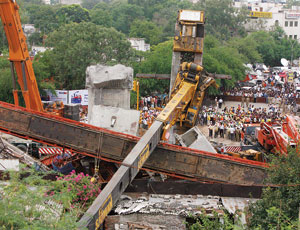A design flaw and inadequate concrete curing in a cantilevered segment of an elevated rail track being built in Delhi, India, caused the July 12 collapse that killed six people, according to a government report released on July 28. The rail agency Delhi Metro Rail Corp. (DMRC) may ban from further work the design-build contractor that holds several other contracts on the system. DMRC also is inspecting 87 piers previously constructed for the project.

A 4.2-meter-long cantilevered segment collapsed when crews with Gammon India, Mumbai, used a launching girder to place another segment for a 20-kilometer-long new rail line under construction from Delhi to the southeast. Delhi Metro Rail Corp.’s investigative panel was charged with producing a report in 10 days.
Urban Development Minister Jaipal Reddy, citing the report, told India’s Parliament the accident was caused by “serious deficiency” in design of the cantilevered segment and that the concrete did not have “adequate strength, probably due to lack of adequate curing.”
The cantilever needed reinforcements at points of maximum tension. “The reinforcement detailing had serious deficiency,” says DMRC Managing Director Elattuvalapil Sreedharan.
R.L. Telang, a Gammon India vice president, told a news wire after the accident there was no design fault. But Indian structural engineers Tandon Consultants and Arch Consultancy Services have been banned by DMRC for three and five years, respectively. Two DMRC engineers also have been suspended.
A “show cause” notice is pending for Gammon India, which will have to reply within 21 days to avoid being banned, Sreedharan says. But he notes Gammon holds five contracts on the overall 190-km rail extension program. “We need Gammon’s assistance for restoration on the site—that will take 20 days,” he says. “This is a hazardous job. If we pack up [Gammon] and get a new contractor, it will need around eight months for [the contractor] to get organized.”
DMRC now is inspecting at least 87 piers. Sreedharan says cantilever designs provided in Indian engineering books are out of date.


Post a comment to this article
Report Abusive Comment